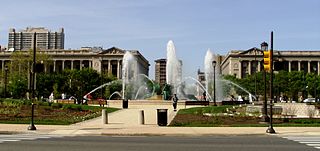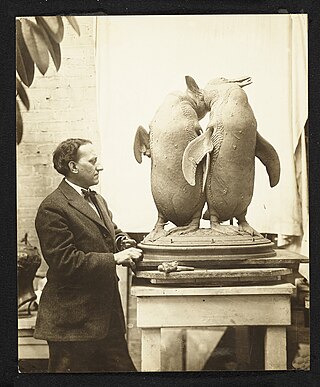
The Philadelphia Museum of Art (PMoA) is an art museum originally chartered in 1876 for the Centennial Exposition in Philadelphia. The main museum building was completed in 1928 on Fairmount, a hill located at the northwest end of the Benjamin Franklin Parkway at Eakins Oval. The museum administers collections containing over 240,000 objects including major holdings of European, American and Asian origin. The various classes of artwork include sculpture, paintings, prints, drawings, photographs, armor, and decorative arts.

Fairmount Park is the largest municipal park in Philadelphia and the historic name for a group of parks located throughout the city. Fairmount Park consists of two park sections named East Park and West Park, divided by the Schuylkill River, with the two sections together totalling 2,052 acres (830 ha). Management of Fairmount Park and the entire citywide park system is overseen by Philadelphia Parks & Recreation, a city department created in 2010 from the merger of the Fairmount Park Commission and the Department of Recreation.

William Rush was a U.S. neoclassical sculptor from Philadelphia, Pennsylvania. He is considered the first major American sculptor.

Alexander Stirling Calder was an American sculptor and teacher. He was the son of sculptor Alexander Milne Calder and the father of sculptor Alexander (Sandy) Calder. His best-known works are George Washington as President on the Washington Square Arch in New York City, the Swann Memorial Fountain in Philadelphia, and the Leif Eriksson Memorial in Reykjavík, Iceland.

Charles Allan Grafly, Jr. was an American sculptor, and teacher. Instructor of Sculpture at the Pennsylvania Academy of the Fine Arts for 37 years, his students included Paul Manship, Albin Polasek, and Walker Hancock.

Fairmount is a neighborhood within Lower North Philadelphia, Pennsylvania, United States. Its boundaries are north of Fairmount Avenue, west of Corinthian Avenue, south of Girard Avenue and east of The Schuylkill River. While this may be the most accurate demarcation, the area's boundaries fluctuate depending how the neighborhood is defined. Several other neighborhoods near Fairmount are sometimes also collectively called Fairmount, including: Spring Garden, Franklintown and Francisville. Fairmount and neighboring Spring Garden are commonly referred to as the "Art Museum Area," for their proximity to and association with the Philadelphia Museum of Art. Fairmount is also the location of the Eastern State Penitentiary.

Paul Philippe Cret was a French-born Philadelphian architect and industrial designer. For more than thirty years, he taught at a design studio in the Department of Architecture at the University of Pennsylvania.

Logan Circle, also known as Logan Square, is an open-space park in Center City Philadelphia's northwest quadrant and one of the five original planned squares laid out on the city grid. The centerpiece of the park is the Logan Circle, a circular area centered on a large water feature, bounded by a traffic circle carrying 19th Street and the Benjamin Franklin Parkway with connections to 18th and 20th streets to the east and west and Race and Vine Streets to the south and north.

The Swann Memorial Fountain is an art deco fountain sculpture located in the center of Logan Circle in Philadelphia, Pennsylvania, United States.
Jacques-Henri-Auguste Gréber was a French architect specializing in landscape architecture and urban design. He was a strong proponent of the Beaux-Arts style and a contributor to the City Beautiful movement, particularly in Philadelphia and Ottawa.

Eakins Oval is a traffic circle in Philadelphia. It forms the northwest end of the Benjamin Franklin Parkway just in front of the Philadelphia Museum of Art, with a central array of fountains and monuments, and a network of pedestrian walkways.
Bike Philly was a bicycle tour of Philadelphia, Pennsylvania, on a closed route cleared of motorized vehicular traffic. The tour is sponsored by the Bicycle Coalition of Greater Philadelphia, and it occurs on the second Sunday of September. The inaugural event for Bike Philly was held on September 9, 2007, and consisted of two 10 mile loops, a Center City route, and a Fairmount Park route. The ride attracted 2,500 riders
SEPTA Route 38 is a bus and former Subway-Surface streetcar route operated by the Southeastern Pennsylvania Transportation Authority (SEPTA) in Philadelphia, Pennsylvania, United States.

Albert Laessle was an American sculptor and educator. He taught at the Pennsylvania Academy of the Fine Arts for more than twenty years and is best remembered as an animalier. He won the 1918 Widener Gold Medal.

Established in 1872 in Philadelphia, the Association for Public Art (aPA), formerly Fairmount Park Art Association, is the first private, nonprofit public art organization dedicated to integrating public art and urban planning in the United States. The association commissions, preserves, promotes, and interprets public art in Philadelphia, and it has contributed to Philadelphia being maintaining of the nation's largest public art collections.

Eli Kirk Price II was a prominent American Philadelphia lawyer, called "the foremost civic and cultural leader in early twentieth-century Philadelphia". He was the commissioner of Fairmount Park during the planning and development of the Benjamin Franklin Parkway, of which he was one of the principal planners. Later, he was instrumental in obtaining funding for the new Philadelphia Museum of Art building and was President of the museum from 1926 to 1933.

All Wars Memorial to Colored Soldiers and Sailors is a war memorial in Philadelphia, Pennsylvania that honors the state's African American servicemen who fought in American conflicts from the American Revolutionary War to World War I. Commissioned by the Commonwealth of Pennsylvania in 1927, it was created by sculptor J. Otto Schweizer and dedicated July 7, 1934. In 1994 it was relocated from a remote site in West Fairmount Park to its present prominent site in Logan Square, along the Benjamin Franklin Parkway.
Wilson Cary Swann was an American physician, philanthropist, and social reformer. Born in present-day Alexandria, Virginia, he moved to Philadelphia in 1847, and spent the rest of his life there. Swann held around 40 slaves, whom he freed shortly after his marriage in 1847.

The General Galusha Pennypacker Memorial is a monument in Philadelphia, Pennsylvania, United States. Located in the city's Logan Circle, the monument honors Galusha Pennypacker, a Pennsylvanian who served as a general officer in the Union Army during the American Civil War. Work on the memorial first commenced under sculptor Charles Grafly, though after his death in 1929, work was continued by Albert Laessle, a former student of Grafly, who completed the sculpture in 1934. The overall design for the sculpture depicts Pennypacker in classical dress descending from a stylized cannon that is surrounded by two tigers.































